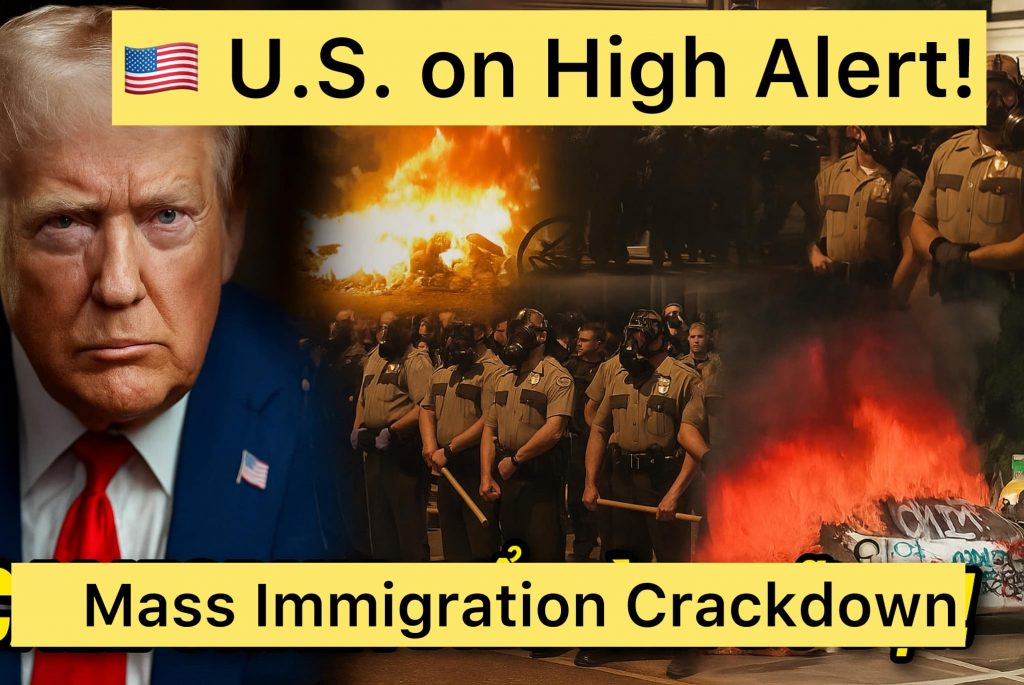U.S. on High Alert: ICE Immigration Raids Spark Mass Protests and Fear Across Immigrant Communities

U.S. on High Alert: ICE Immigration Raids Spark Mass Protests and Fear Across Immigrant Communities
1. America on Edge: Chaos Erupts in California
In recent weeks, the United States has entered a volatile chapter in its immigration history. From Los Angeles to Oakland, cities across California have witnessed large-scale protests, police barricades, and clouds of tear gas filling the streets. The spark? A renewed crackdown by Immigration and Customs Enforcement (ICE), reportedly arresting up to 3,000 undocumented immigrants every day.
Videos of ICE raids, protesters chanting “No human being is illegal,” and families torn apart have flooded social media. The situation has alarmed not only undocumented individuals, but entire immigrant communities who now live in fear, uncertainty, and distrust.
2. The Reality Behind the Numbers
The headline “3,000 Arrests a Day” sounds like a statistic. But behind every number is a person — often someone who has lived in the U.S. for years, paid taxes, worked hard jobs, raised children, and avoided legal trouble. Many are parents of U.S. citizen children, workers in essential industries, and active members of their local communities.
This new wave of ICE enforcement comes under the revived “Zero Tolerance” policy — reminiscent of previous efforts under the Trump administration, where immigration laws were enforced with sweeping, non-discretionary force.
But unlike 2020, today’s enforcement is occurring in a highly politicized climate, where even law-abiding immigrants — documented or not — fear becoming collateral damage.
3. Who Is Really Affected? It’s More Than Just the Undocumented
Though ICE targets those without legal immigration status, in reality, the impact ripples far beyond:
- Legal immigrants fear mistaken identity or overreach.
- Mixed-status families worry about being separated.
- Children of immigrants show signs of anxiety and trauma from seeing friends or family detained.
Some people have even reported being questioned while waiting at bus stops, standing in line at grocery stores, or simply speaking their native language in public spaces.
In short, this is not just about “illegal” immigration — this is about how immigrant communities are being treated as a whole.
4. Protests Across California: From Outrage to Tear Gas
The protests in California erupted after video footage showed ICE agents storming residential neighborhoods in the early hours of the morning, dragging people from their homes with no prior notice or due process.
Within days, thousands gathered across cities to protest. In San Francisco and Sacramento, demonstrators locked arms to block ICE vehicles. In Oakland and Los Angeles, peaceful gatherings turned tense as riot police deployed tear gas and rubber bullets.
Mothers with children cried in the chaos.
Elderly immigrants were caught in stampedes.
Helplessness turned into rage.
These protests were not organized by radical activists, but by neighbors, teachers, and clergy, united by one belief: that immigrant lives deserve dignity and humanity.
5. Local Governments Push Back
California’s leadership has taken a defiant stance against federal immigration policies.
Governor Gavin Newsom publicly criticized ICE’s actions, stating:
“California will not serve as an arm of the federal deportation machine. We will not abandon our communities.”
Several California cities, including Sanctuary Cities like San Francisco and Berkeley, have refused to cooperate with ICE, limiting local police from assisting in raids or sharing data.
However, ICE has sidestepped this resistance by deploying federal agents directly, bypassing local jurisdictions, and enforcing immigration laws without local consent.
This creates legal and political conflict — but the real losers are the people caught in the middle.
6. The Psychological Toll on Immigrant Communities
The fear of deportation is no longer reserved for the undocumented. It has become a shared anxiety for entire neighborhoods.
Common effects include:
- Chronic stress and sleep disorders
- Children afraid to go to school
- Workers afraid to commute or speak up
- People refusing to seek medical help for fear of being reported
Some are staying home, cancelling doctor visits, skipping church, and avoiding public events. The emotional cost is devastating and almost invisible to the wider public.
7. Economic Disruption: Undocumented but Essential
Many of those being targeted by ICE are part of the backbone of the U.S. economy:
- They harvest food, care for the elderly, build homes, and clean hospitals.
- They work jobs most Americans avoid.
- They pay billions in taxes — despite not being eligible for most federal benefits.
With raids increasing, businesses are losing labor, and sectors like agriculture, hospitality, and home care are feeling the strain.
What happens when fear empties out the workforce?
The answer: America suffers too.
8. A Crisis of Conscience: What Kind of Country Do We Want to Be?
The deeper question in this debate is not only about policy — it’s about morality.
Should a mother who has lived here 20 years and raised U.S. citizen children be torn from her home without warning?
Should children be left waiting at school, only to find their parents never returned?
Should peaceful communities live in fear of knock-on-the-door raids?
Is this justice — or cruelty disguised as law enforcement?
9. A Message to Undocumented and Immigrant Communities
If you are undocumented or part of a mixed-status household, here are a few important tips:
? Know Your Rights:
- You do NOT have to open the door to ICE without a signed court order.
- You have the right to remain silent.
- You have the right to speak to a lawyer.
? Stay Informed:
- Follow trusted local immigrant rights organizations.
- Prepare a family emergency plan (especially if you have children).
? Avoid Hotspots:
- Stay away from areas with ongoing protests or police activity.
- Always carry identification if you’re traveling.
? Seek Legal Aid:
- Organizations like RAICES, United We Dream, and National Immigration Law Center (NILC) offer free or low-cost legal resources.
10. Final Reflection: Hope Amidst Chaos
Despite the chaos, the fear, and the injustice — there is solidarity.
There are people standing up.
There are lawyers working overtime.
There are churches offering shelter.
There are students marching beside their classmates.
America has always been a country shaped by immigrants. And history shows us that when injustice rises, so does resistance.
Let this be a reminder:
Undocumented does not mean undeserving.
Immigrant does not mean invisible.
And no matter how dark the night may seem — hope is never deported.
ImmigrationRaids #UndocumentedLives #ICEProtests #ImmigrantRights #MassDeportation #TearGasInCalifornia #USImmigrationCrisis #HumanRightsMatter





